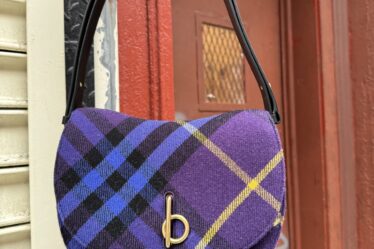HERZOGENAURACH, Germany — Adidas’ Samba has been perhaps the most popular sneaker on the market for the past year, winning fans from Kendall Jenner to former UK prime minister Rishi Sunak and millions of customers in between.
But that wasn’t Adidas’ original plan.
When Bjørn Gulden took over as the German brand’s chief executive in January 2023, just as the Samba was starting to get hot, he learned Adidas wasn’t planning to ramp up production of the shoe until the second half of 2024.
“For whatever reason, no one wanted to scale it,” the cheerful 58-year-old Norwegian — whose Instagram bio reads “Life is Good!” — said in an interview at Adidas’ global headquarters this month. “It took five days [of being in the job] to say: ‘Hey, we’re scaling production’ and then to get the people that told me no to change their minds.”
At the time, the company needed a jolt. Gulden, who jumped to Adidas after nearly a decade as CEO of local rival Puma, parachuted in after the damaging loss of its Yeezy line a few months earlier. October marks two years since Adidas terminated its contract with Ye, formerly Kanye West — a deal which at the time accounted for as much as 8 percent of Adidas’ annual revenue — plunging the company into a dramatic PR and financial crisis that sent its share price to its lowest point in a decade and resulted in four profit warnings in less than a year.
It also had taken a hit with the closure of its Russia business — its largest market in terms of direct-to-consumer sales — after the invasion of Ukraine, while sales slowed in China, which before the pandemic had been Adidas’ fastest-growing market.
Thanks to the quick Samba pivot, which boosted production to millions of units by the end of last year, as well as the success of other “terrace” styles like the Gazelle and new silhouettes such as the Anthony Edwards 1 basketball sneaker, Gulden and Adidas have achieved a turnaround far quicker than anyone anticipated. In July, Adidas improved its full-year guidance for the second time this year, projecting revenue to grow at a high single-digit rate, compared to the initial mid single-digit growth rate forecast. Adidas also said it expects operating profit to reach €1 billion ($1.1 billion), up from an initial forecast of €700 million. Shares are up 20 percent this year, and up 130 percent since October 2022, when the Yeezy partnership collapsed.
Analysts and insiders attribute much of the turnaround to Gulden, citing his genuine love for sports and the brand’s athletes, his empowerment of Adidas’ creative teams by giving them more freedom to make decisions and his uncompromising, product-first approach.
“The key with Bjørn is his understanding around product — and that he’s been obsessed with product and footwear forever,” said Erwan Rambourg, global head of consumer and retail research at HSBC.
Next, Adidas has its eye on North America, the home turf of its biggest rival, Nike, whose current slump presents Adidas with its biggest opportunity in years to steal share in the critical market. Nike’s impending CEO change underscores its precarious footing, but also that Adidas may have a limited window to strike in North America before its rival engineers a turnaround of its own. Last year, Adidas opened a large office and “creation centre” in Los Angeles to bring a more local perspective to its US business and capitalise on its success in basketball.
In interviews with The Business of Fashion, Gulden and other top Adidas executives discussed how the brand has course-corrected in several areas, speeding up its decision-making, leveraging its sports connections and rebuilding wholesale relationships.
“Turning around a company has three components: It’s luck, it’s timing and it’s effort,” said Gulden. “I don’t know how much of each of these things contributed at any point in time, but it was obvious to me [from day one] we had good things bubbling that people hadn’t realised.”
Culture Change
The Samba exemplifies the cultural change Gulden has sought to usher in since his first week at Adidas. Quicker, more independent decision-making was high on his agenda, as he felt the brand had become too risk-averse and defensive, hampered by the advice of management consultants. (“I’m not a big fan of consultants,” said Gulden. His departing counterpart at Nike, by contrast, is the former CEO at consultancy Bain & Company.)
Examples of this new approach include the brand’s latest racing supershoe, the ultra-lightweight Adizero Adios Pro Evo 1, which first appeared on the feet of Tigist Assefa, who broke the women’s marathon record in Berlin last September.

“We saw it performing well in all the tests. Instead of waiting a year from now to continue testing, we gave it to 50 elite runners across Africa who loved the shoe, so we just launched it right away — and we’ve won every marathon since,” Gulden said. (Each of the last five major world marathons has been won by an Adidas athlete either in the men’s or women’s competitions, since the introduction of the shoe).
Gulden, who previously worked for Adidas in the 1990s as senior vice president of apparel and accessories, has shown a keen understanding of the marketplace from a product perspective. In the Samba, he saw an opportunity to exploit a gap. The shoe — a low-profile football sneaker with suede accents — offered a fresh alternative to the chunky, retro basketball styles like Nike’s Air Force 1 that had dominated for years. Successful collaborations with designers like Grace Wales Bonner and Gucci helped boost its cultural credibility while serving as a way for Adidas to introduce new colour combinations unlike anything on store shelves.
It was just the right item to make up for the shortfall from the loss of what Rambourg described as the “super profitable, high margin” sales of Yeezy sneakers. “The gross margin on [terrace sneakers] is likely super high because there’s no specific technology, it’s essentially a lifestyle product, it’s very easy to produce and they’re mostly sold at full price,” Rambourg said.
Under Gulden, Adidas’ designers, who under the previous regime were constantly reminded of commercial targets and given rigid objectives, have more creative licence and are challenged to break out of their routines. He’s insisted, for instance, that the product and design teams work with physical samples rather than using virtual scans — filling their section of the campus with 36,000 product sample units. Recently, the brand has begun teasing a futuristic-looking, fully 3D-printed sneaker, known for now as the “Climamog”, designed to adapt to the shape of a user’s foot that’s currently being tested among athletes and influencers ahead of a wider launch next year.
“You can’t overstate the value of the inspiration and newness that Adidas has brought to the market,” said Scott Cutler, CEO of resale platform StockX, which has seen rising sales for Adidas shoes. “It’s resonating especially at a time where the challenge in other brands has been oversaturation and a lack of innovation that people are growing tired of.”
Rebuilding Relationships
It wasn’t just internally that Gulden wanted to make changes.
“In the previous period [before Gulden’s arrival], we maybe lost our identity a little bit,” said Alasdhair Willis, Adidas’ chief creative officer, who joined the company in March 2022. “We realised we needed to re-focus again on the connection with our athletes because we’d slightly lost a little of that direct relationship — the brand’s founding principle was to serve the athlete.”
Just as Nike is a brand synonymous with basketball, Adidas’ three stripes have been intertwined with football (aka soccer) since the 1950s. But a pain point both among employees and the brand’s critics was that Adidas had lost its connection with the sports world and was becoming too much of a lifestyle brand.

Gulden, a former professional footballer who describes himself as a “sports romantic,” was at pains to put this right. He pushed Adidas to lean more heavily into football and leverage its unmatched roster of stars, including legends like Zinedine Zidane to rising talents like Jude Bellingham. The brand is featuring them more in campaigns, using them for the relaunch of its F50 and Predator football boots, bringing them in to meet retail partners and building collections around them — Bellingham even got his own signature logo this year.

“He’s really good at having athletes not just for marketing, or figures on a P&L, but as proper, long-term partnerships,” said Rambourg, who noted that for Gulden these aren’t just professional relationships. “He’s actually buddies with these people.”
Adidas is applying that sport-centric approach to reviving interest in long-running fashion partnerships. Stella McCartney designed kits for Arsenal Women FC last year, while Bellingham and Zidane featured in an arty Y-3 campaign earlier this year. At the Paris Olympics, American sprinter Noah Lyles won gold wearing Y-3 Adidas spikes.
Gulden’s tenure hasn’t been without missteps. In July, Adidas pulled commercials featuring Bella Hadid for its SL72 sneaker, originally created to celebrate the 1972 Munich Olympics. But during those games 11 Israeli athletes were killed in a terrorist attack, and the involvement of Hadid, an outspoken critic of the Israeli government of Palestinian descent, drew widespread criticism online. Adidas ultimately apologised.
Basketball, North America and Beyond
The other revival Gulden has made a priority is Adidas’ relationships with retail partners. Like Nike, it had backed away from wholesale in recent years as it prioritised sales through its own channels. During his tenure at Puma, his wholesale-first approach saw him build close relationships with retailers that helped to increase sales as Nike and Adidas were vacating store space.
Frank Bracken, chief commercial officer at Foot Locker, said the way Adidas trusted the retailer for its expertise in basketball and the North American market during the launch of its AE 1 sneaker recalled the partnership approach Gulden was known for in his Puma days.
“Of course, it’s their product, their athlete, but Adidas leaned on us, listened to us and had their product development and marketing teams work hand-in-hand with our teams to get that launch right,” Bracken said.
North America and basketball will be central to Adidas’ strategy as it looks to extend its winning streak. The new Los Angeles office is meant to give Adidas a better launching pad for its work on both while it gets ready for major US sporting events such as the 2026 World Cup and the 2028 LA Olympics. The company is still in the process of rebuilding its foothold in the market after the loss of its Yeezy products, the last of which will be sold by the end of this year.
“The LA office is an opportunity for us to directly tap into that melting pot of sports, culture and entertainment,” said Torben Schumacher, senior vice president and global general manager of Adidas originals, basketball and partnerships, who relocated after almost 20 years at Adidas headquarters in Germany to lead the Los Angeles expansion. “It really becomes a launchpad for the Adidas business we are building in North America.”
It’s a move Adidas is mirroring in China — where sales grew nine percent year-over-year in the last quarter after years of decline — and Latin America. It also marks another departure from the brand’s approach under Gulden’s predecessor, Kasper Rørsted, who had centralised much of the decision-making in Germany.
According to Gulden, the goal is to give its local offices more freedom on creating products, setting go-to-market timelines and tapping into local supply chains to be more agile as it chases its ambitions.
They don’t include taking silver while Nike gets the gold.
“First of all, you have to have a lot of respect for what Nike has achieved,” Gulden said. “But we have to ask ourselves: Is there any reason that Nike or any other brand should be bigger than us in the next 10 years? I can’t find any rational answer to say so.”



